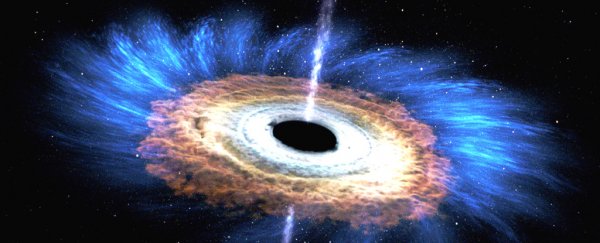Astronomers just spotted what they think is the fastest-growing black hole ever discovered in the Universe, and it's got a voracious appetite, sucking in the equivalent of the mass of our Sun every two days.
To find this "monster" of a black hole, the researchers had to peer some 12 billion light-years across space – which also means they're seeing the object as it would have looked 12 billion years ago, not too long after the Big Bang.
The black hole is only visible because of its incredible brightness: If it was inside the Milky Way, it would light up more brightly than a full Moon to people on Earth, the astronomers say, making all the other stars in the night sky look dim by comparison.
"This black hole is growing so rapidly that it's shining thousands of times more brightly than an entire galaxy, due to all of the gases it sucks in daily that cause lots of friction and heat," says one of the team, Christian Wolf from the Australian National University (ANU).
"If we had this monster sitting at the centre of our Milky Way galaxy, it would appear 10 times brighter than a full Moon. It would appear as an incredibly bright pinpoint star that would almost wash out all of the stars in the sky."
Not only that, it would also wipe out all life on Earth, thanks to the X-rays being beamed out as the black hole goes on its matter feeding frenzy. Lucky for us we've got that 12 billion-year buffer.
Scientists estimate that the newly found supermassive black hole – technically known as QSO SMSS J215728.21-360215.1 – is the size of 20 billion Suns and is growing at a rate of 1 percent per million years.
With so much material getting sucked in, the object qualifies as a quasar, one of the rarest and brightest celestial objects, known to sit in the centre of galaxies.
The quasar was found by poring over data from the ESA Gaia satellite, the NASA Wide-field Infrared Survey Explorer (WISE), and the ANU SkyMapper telescope.
With more powerful telescopes coming online in the next few years, the process of spotting more objects like this should get easier.
And that will mean we'll get a better understanding of how elements and galaxies were formed in the very early stages of the Universe. As supermassive black holes like these grow, the shadows of other objects can be spotted in front of them.
The powerful shining lights of these quasars and the black holes inside them act as beacons, the researchers say – the way they ionise gases around them can make the Universe more transparent to our telescopes.
We might be able to better tell how planets and galaxies began to knit together, in other words.
To date only a few quasars and supermassive black holes of this magnitude have been discovered. Now the challenge is to work out how these objects were able to grow so fast, to such large sizes, so early in the formation of the Universe.
"We don't know how this one grew so large, so quickly in the early days of the Universe," says Wolf. "The hunt is on to find even faster-growing black holes."
The research is due to be published in Publications of the Astronomical Society of Australia and is available now on the arXiv.org pre-print server.
